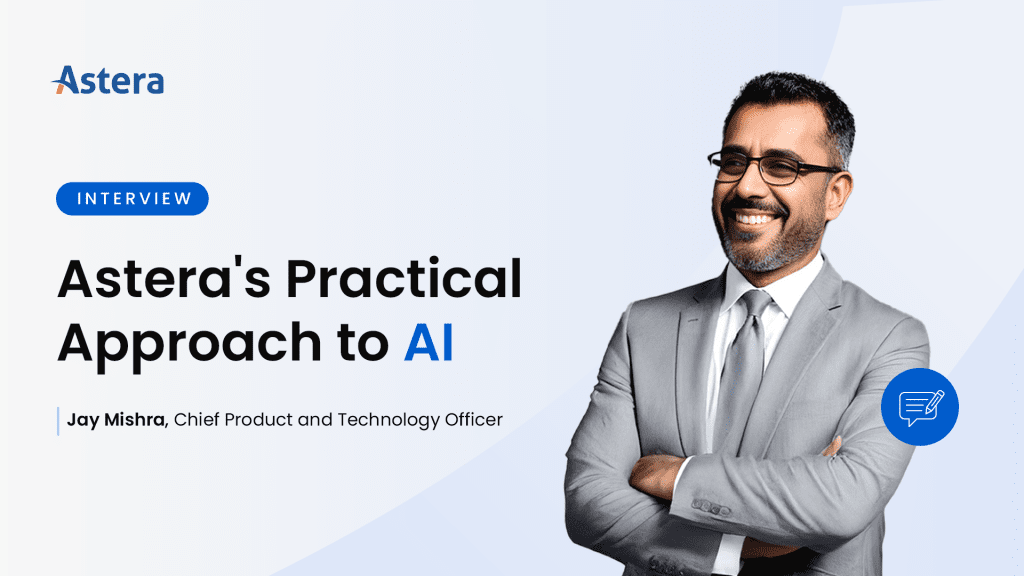
At Astera, we believe in leading the charge. We know that AI is changing the way we handle our data, and that integrating AI can be intimidating. But it doesn’t have to be.
In this candid interview, our Chief Product and Technology Officer, Jay Mishra, breaks down how we’re making AI accessible and practical. Jay explains how we’re putting AI’s power right at your fingertips, without requiring you to learn coding. Our goal is to make AI an agile partner, integrated into every corner of our data management platform, so you can find insights quickly and easily. Let’s dive in:
Q: Astera is making big moves in the AI space. Can you give us a quick overview of how you’re incorporating AI into your products?
A: Absolutely! We’re taking a two-pronged approach with AI here at Astera, focusing on both product usability and the developer experience.
First off, on the UX side, we’re enhancing our solutions with AI to make life easier for our users. This means faster configuration of ETL pipelines, data warehouses, and intelligent document processing, all leading to quick, seamless implementation. We’re tackling two big areas here:
- Putting Document Processing on Autopilot: Intelligent Document Processing is the main area where we are heavily utilizing AI. The entire document workflow, from ingestion to mapping to extraction and integration, is now handled by AI.
- AI-Powered Data Pipelines: Imagine building entire data pipelines just by chatting with the platform! Users can use natural language through a chat interface to set up pipelines, joining tables, adding filters, and more.
Then we have the developer side, where things get really fun. We’re extending our ETL environment to bring AI directly into the developer workflow. Here’s what that looks like:
- Using Prompts as Transformations in Workflows: Developers can now add AI processes directly as transformations in ETL workflows, making AI integration as easy as asking, and having transformations built in. It skips the heavy lifting and gets right to the action!
- RAG Builder: And we’re diving into RAG, building out ‘retrieval-augmented generation’ workflows to help users quickly pull precise information from documents based on queries.
But it’s important to note that we’re bringing AI into Astera at the design stage rather than at runtime, and there’s a reason for that. AI’s deterministic nature just doesn’t hold up well in real-time, we’ve seen it firsthand.
Q: It’s fascinating how Astera is bringing AI into both user and developer experiences! With Intelligent Document Processing as a key focus, how exactly is AI enhancing this area?
A: IDP is actually where we see the most transformative potential. We’re using AI to completely automate the document ingestion process.
Think of it like this: our customers are dealing with a mountain of documents coming in from all sides: Excel, PDFs, CSVs, you name it, all in different formats. Normally, that would be a headache to manage. But now, we’ve integrated AI to automate the document processing configurations.
Here’s how it works now: AI automatically identifies the file type, matches it with the right template, extracts the data, and even generates mappings automatically if they don’t exist! It even gives the user a quick review step to make sure it’s all good.
So now, from start to finish, document processing is on autopilot. It’s our biggest AI win yet, and let’s just say, it’s saving everyone a ton of time and effort.
![]()
Astera Intelligent Document Processing
Q: Earlier you talked about building entire pipelines just by chatting with the platform. How does that work?
A: So, we’re using AI to speed up data pipeline configurations like never before. We’re moving beyond the traditional drag-and-drop interface that everyone loves by adding AI and natural language processing on top of it. Now, you can build data pipelines just by talking to the system. This makes it even easier and faster to set up complex workflows, and you don’t have to be a technical expert to do it.
Imagine building out your whole pipeline through a chat interface. You just type, ‘Hey, I have these two tables, can you join them?’ and then, ‘Filter them by this’, and AI takes it from there. No manual clicking around, just straight-up instructions in human language, and the pipeline builds itself.
Of course, we still let you double-check the AI’s work because we all know AI isn’t above a second opinion, and once it’s good to go, you’re off and running. We’re aiming for a data pipeline that’s not just faster but smarter, doing the heavy lifting while you keep it conversational.
Q: It sounds like Astera has a strong focus on making the entire experience smoother for users. What has motivated this shift?
A: Absolutely. Since we started back in 2003, user experience has been at the heart of everything we do at Astera. Our customers stick with us because we actually listen to their feedback and make changes based on what they need. Right now, we’re zooming in on a few key areas, and they’re all powered by AI.
Our customers care about three main things: minimal setup time, reliable output, and speedy processing. They want solutions that save time and money without needing to bring in extra technical resources or juggle data just to get valuable insights.
So, we’ve doubled down on what we do best, like IDP and data pipelines, and we’re giving them a complete AI makeover. We want to make things smarter and faster so our customers can get straight to the insights that matter.
![]()
Q: How does integrating AI directly into the ETL environment benefit the developers?
A: We saw that ETL developers and data scientists were practically living in separate worlds. Let’s say you’ve got 50 ETL developers building data pipelines, ensuring data quality, and managing the warehouse. But the moment an AI task pops up, they have to hand it over to the data science team. Suddenly, we’re talking Jupyter notebooks, Python, and tools ETL developers usually don’t touch.
So, we decided to bridge the gap. Now, ETL developers can incorporate AI directly into their workflows using AI prompts as transformations. They no longer need to rely on separate teams for AI tasks. This means ETL and AI development can coexist in one platform, speeding up the entire process.
Here’s how it works:
- ETL developers can create and save custom LLM-based transformations that can be reused across workflows, cutting down on repetitive work.
- Users can define properties and save them as templates, which can be used across multiple projects. For example, a template that generates SQL queries can be reused whenever it’s needed.
- These templates are saved in a plugin folder, making them accessible across teams. Whether it’s semantic matching or SQL generation, repetitive tasks are simplified, allowing teams to focus on the more exciting stuff.
In short, we’re giving ETL developers the AI tools they need, right in their own environment, eliminating handoffs and extra steps for faster results.
Q: RAG is an area of growing interest. How is Astera approaching this technology to benefit users?
A: Absolutely! With our RAG, or Retrieval Augmented Generation, the goal is really to simplify life for users who need quick, accurate answers from massive document collections. It’s a dynamic, super-smart search tool that goes way beyond just fetching keywords.
Usually, you’d think setting up a RAG pipeline would require an army of AI experts working around the clock. But with Astera, that’s not the case. We’ve designed it so even business users, not just the technical users, who understand data, metadata, and data structures can build their own RAG pipelines. And the best part is that they can do it in minutes.
Astera’s RAG setup is completely code-free, instant, and keeps all data secure within your organization. This means your team can quickly search through large document collections to find specific details, contextual information, and valuable insights, exactly when they need them.
![]()
Astera RAG Builder
Q: What are your final thoughts on where Astera is headed with these AI initiatives?
A: Astera is on an exciting journey, dedicated to creating a unified, intelligent data solution that addresses today’s evolving business needs. Many organizations still struggle with fragmented systems and manual, time-consuming processes. To change that, we’re bringing together AI, data pipelines, document processing, cloud capabilities, and chat features into a single, easy-to-use, code-free platform. By focusing on AI-driven automation and user experience, Astera is redefining data management, and we’re just getting started.
A huge thank you to our Chief Product & Technology Officer, Jay Mishra, for sharing Astera’s vision for AI. If you’d like to see how Astera Intelligence can make your data management smarter, faster, and scalable, contact us today!
 Apr 29th | 11 AM PT
Apr 29th | 11 AM PT

